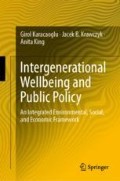Abstract
We concluded Chap. 3 with a few numerical simulations, to demonstrate how environmental, social, and economic factors interact in influencing wellbeing. We deliberately used a very condensed version of the stylised model of Chap. 2 for those numerical simulations. Our purpose was simply to highlight the operation of some of these key interactions. If we wish to use such a model for policy purposes, we have to work with a complete model. Is that feasible? Can the stylised model of Chap. 2 be operationalised as a tool for the design and prioritisation of public policies aimed at improving wellbeing? Building such an operational policy model is currently work in progress at the New Zealand Treasury. The purpose of this chapter is to summarise the modeling strategy that is guiding this effort. We do so with the assistance of diagrams; the underlying mathematical model can be found in King (2018), which is available online. The model represents the interactions among the eleven key influences on wellbeing, which are the components of the OECD Better Life Index (BLI) as presented in Fig. 1.1, as well as between these influences and the capital stocks that comprise “comprehensive wealth” (as we discussed in Chaps. 1 and 2). Our discussion also covers the purpose of, and sensible uses for, the model, as well as ways of interpreting and communicating the results of the policy simulations to be performed with such a model. At the end of the chapter, we trace the results of a few policy simulations with the help of diagrams, but in a qualitative way that simply highlights the directions of responses to policy adjustments. The purpose of these exercises is again, as in the simulations conducted at the end of Chap. 3, to highlight the interactions between environmental, social, and economic factors in influencing wellbeing, as a basis for guiding policy choices and prioritisation. The quantification of these simulations, so that they can inform actual policies, is work in progress at the New Zealand Treasury. Nevertheless, even the qualitative model is sufficient to guide the policymakers in their choices of sets of complementary policies that are required to guide the system towards an improvement in wellbeing – taking into account the complementarities and tradeoffs between the responses to policy changes.
Access this chapter
Tax calculation will be finalised at checkout
Purchases are for personal use only
Notes
- 1.
As already stated, a method for the model quantification can be found in King (2018).
- 2.
King (2018) provides the sub-models for formal education and skilling.
- 3.
Author information
Authors and Affiliations
Corresponding author
Rights and permissions
Copyright information
© 2019 The Author(s), under exclusive license to Springer Nature Singapore Pte Ltd., part of Springer Nature
About this chapter
Cite this chapter
Karacaoglu, G., Krawczyk, J.B., King, A. (2019). Operational Policy-Simulation Model. In: Intergenerational Wellbeing and Public Policy. Springer, Singapore. https://doi.org/10.1007/978-981-13-6104-3_4
Download citation
DOI: https://doi.org/10.1007/978-981-13-6104-3_4
Published:
Publisher Name: Springer, Singapore
Print ISBN: 978-981-13-6103-6
Online ISBN: 978-981-13-6104-3
eBook Packages: Economics and FinanceEconomics and Finance (R0)

